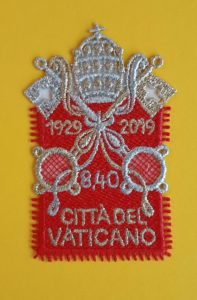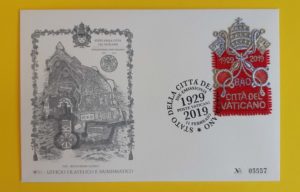90th anniversary of the foundation of the Vatican City State
Despite the fact that the Office of Papacy has been in existence for almost two thousand years, the history of Vatican as a sovereign independent state is relatively short. Even Czechoslovakia was founded a decade earlier. The Vatican City State (Stato della Cità del Vaticano) was created by the signing of the so-called Lateran Treaties on 11 February 1929. These treaties were signed between the Holy See (represented by Pope Pio XI) and the Kingdom of Italy (represented by the then Prime Minister Benito Mussolini). The treaties determined relations between Vatican and Italy and also provided for compensation (financial or state bonds) by which Italy compensated Vatican for the loss of a vast territory of the so-called Papal State. The Treaties established the boundaries of the city state as well as its extraterritorial territories.
The new city state, like any sovereign state, began to issue postage stamps. The first series (the so-called Concilliazzione) with an effigy of Pope Pio XI was published on 1.8.1929. Despite Vatican’s relatively short history, its postage stamps are popular among collectors and represent a significant source of income for the city state. The motives depicted on Vatican postage stamps are, of course, closely linked to Christianity, its history and, of course, to the Pope as head of state and Catholic Church. The issuance of Vatican postage stamps also has its own specificities compared to other countries. Each year’s volume contains stamps celebrating Christmas – the birth of Christ (Natale) and Easter – his resurrection (Pasqua). In the case of the death or abdication of the Pope, a special series of stamps is issued so-called Sede Vacante, when a new pope is elected, a series with his portrait. Particular attention is paid to the pope’s foreign travels as well as to the promotion of fine arts.
Why collect Vatican postage stamps? In addition to close attention paid to their artistic and technical processing, stamps are issued in a relatively limited number (some blocks only in the number of several tens of thousands of pieces). But even Vatican has had a short period of “mass” stamp printing, but it was of a relatively short duration: it began in the 1960s and ended with the beginning of the pontificate of John Paul II.

Figure 1: Commemorative stamp issued on the 90th anniversary of the establishment of the Vatican City State.
On the 90th anniversary of the foundation of the Vatican City State, a commemorative stamp was issued. As is often the case with Vatican philately, this stamp is surprising – instead of traditional paper, textile was used for its production. (see Figs. 1 and 2).

Figure2: FDC issued on the 90th anniversary of the establishment of the Vatican City State.
Photos used in this article – private collection of the author.
